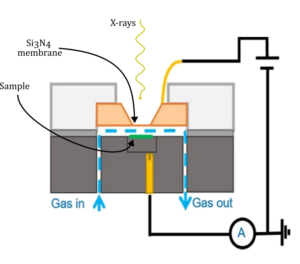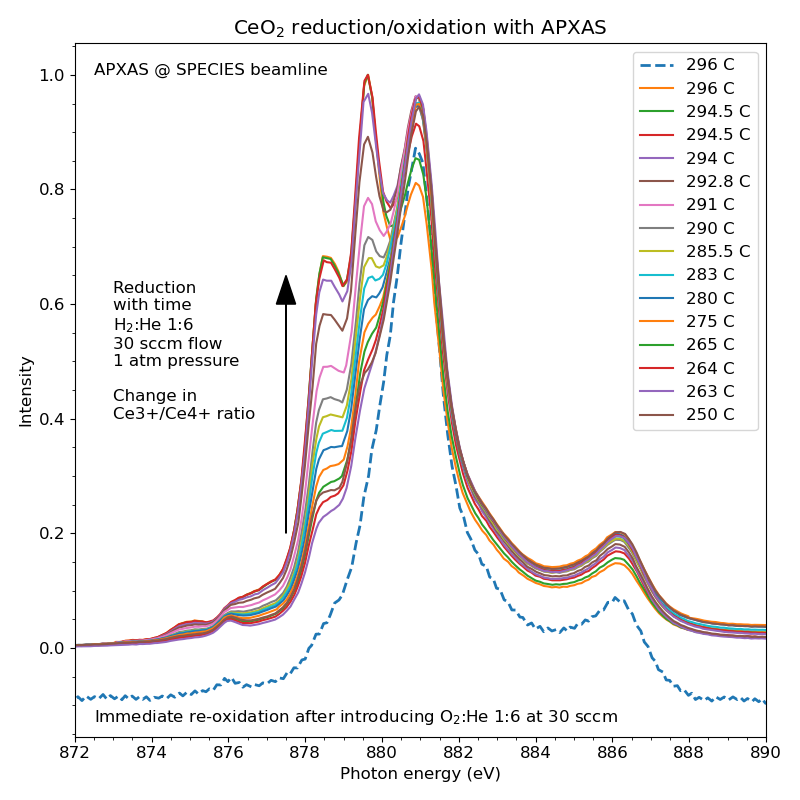The environmental chamber is devoted to perform in situ/operando ambient pressure X-ray absorption spectroscopy (APXAS) to investigate the physical-chemistry properties of materials employed in catalysis, absorption and energetic fields.
X-ray Absorption Spectroscopy (XAS) at SPECIES can be exploited to detect surface or buried atomic species displaying characteristic absorption edges in the relevant energy range (30-1500 eV). APXAS experiments are executed in total electron yield mode that are surface sensitive (few nm of probing depth). Several currents are measured simultaneously for each XAS spectrum. One records the drain current at the entry of the end station (mesh) for intensity normalization, a second one measures the drain current of the sample, and a third one records the drain current of a reference sample, covering the whole range of energies, which is used as a reference of the photon energy.
The high pressure cell

The cell consists of a miniaturized reaction volume (approx 4 cm3). All gases are mixed outside the reaction volume and fed into the cell through a common inlet. Gases flow through the cell and exit the cell after which the gases are directed to evacuation lines.
The gas system consist of four mass flow controllers. One is used for He (carried and buffer gas), which means that three gases can be controlled simultaneously. Typical flows of each gas are in the order of 1 – 50 sccm. The cell is almost always operated at 1 bar pressure (i.e. atmospheric pressure). It is possible to evacuate the cell to a rough vacuum.
The synchrotron radiation enters the cell via a Si3N4 window. The membrane is supported on a 10 x 10 mm size frame which has an aperture of about 0.5 x 0.5 mm. The thickness is about 100 nm.
The sample heating is achieved using a cylindrical cartridge heater located on the body of the cell just underneath the sample, on the UHV side of the cell (i.e. not in the reaction volume). This allows heating up to about 400 C. Sample temperature is read through a K-type thermocouple in contact with the sample plate very near the sample itself.
There are several different variants of the cell available for all users:
- Intermediate temperature reactor: Up to 350 C
- High temperature reactor: Up to 550 C (with water cooling)
- Low temperature reactor: Down to -80 C (with LN2 cooling)
- XMCD cell with an electromagnet.
Example data
Below an example results are shown from the classical case of reduction and reoxidation of CeO2 powder.

Practical information
Samples are mounted on special sample holders, which are quite versatile. Acceptable samples are powders, films, and crystals. For powders, the samples have to be pressed to form pellets on special holders (few mg of powder is required). Other samples (films, crystals) are attached using conductive silver paint to glue the samples in.
Sample dimension: The sample holder accepts quite wide samples (max 2 cm x 2 cm). The thickness requirements are stricter: The sample should not be any higher than 2.5 mm.
The XMCD cell has less space for samples due to the placement of the electromagnet. Samples should be approximately 5 x 5 x 1 mm.
Changing sample involves removing the entire reactor from the vacuum chamber. Typical time from venting the chamber, removing sample and installing new, and pumping down the chamber again, is about 1-2 hours. Users will be introduced how to carry out this procedure.
Proposal submission
Note that this endstation is completely different from the APXPS at SPECIES (i.e. it is not possible to carry out XPS at the same time). When submitting your proposal, please only select one of the endstations to indicate where the experiment takes place.
The proposals are reviewed by the same committee as for the APXPS endstation. Therefore it is important that the “Spectroscopy – APXPS” research area is selected during submission.
References
The cell is placed at SPECIES together in collaboration with IOM-CNR (Italy) and APE-HE beamline with Dr. Piero Torelli (contact information)
A reaction cell for ambient pressure soft x-ray absorption spectroscopy
C. Castán-Guerrero, D. Krizmancic, V. Bonanni et al.
Rev. Sci. Instrum., 89, 054101, (2018)
DOI: 10.1063/1.5019333